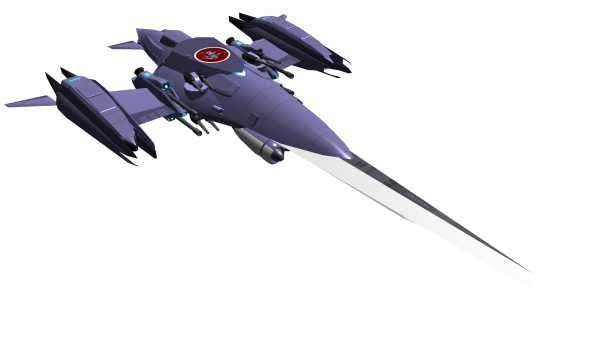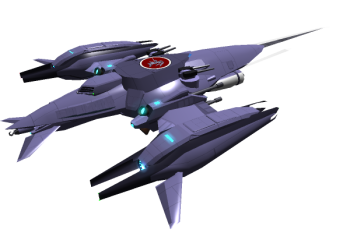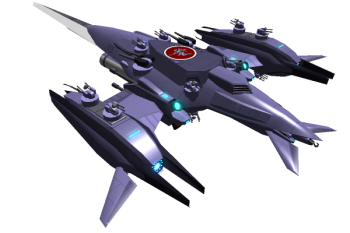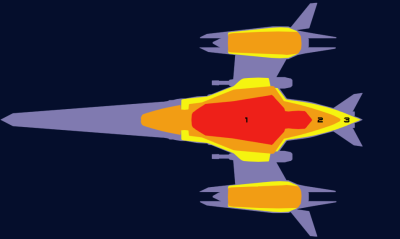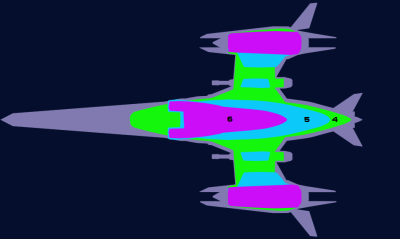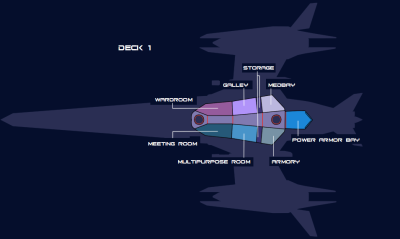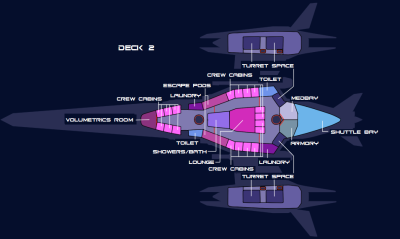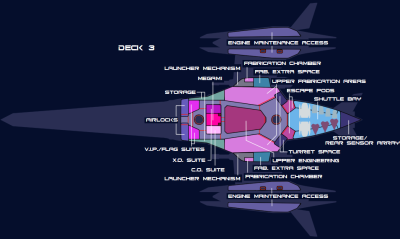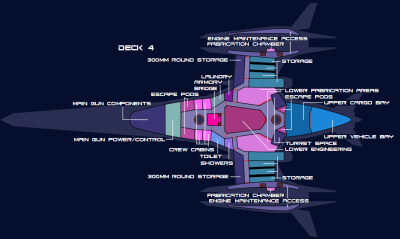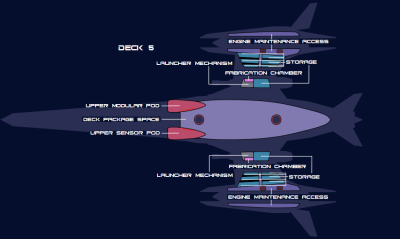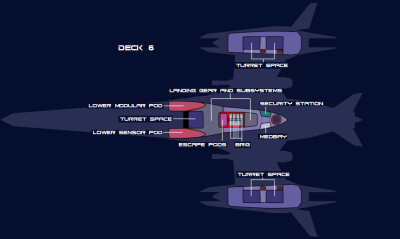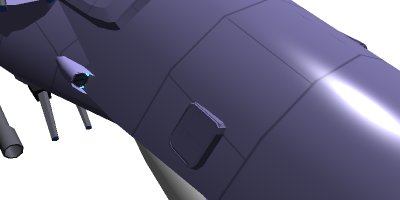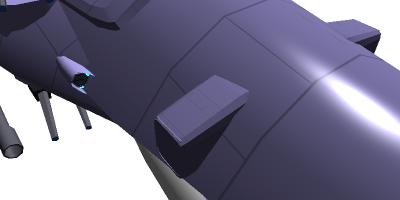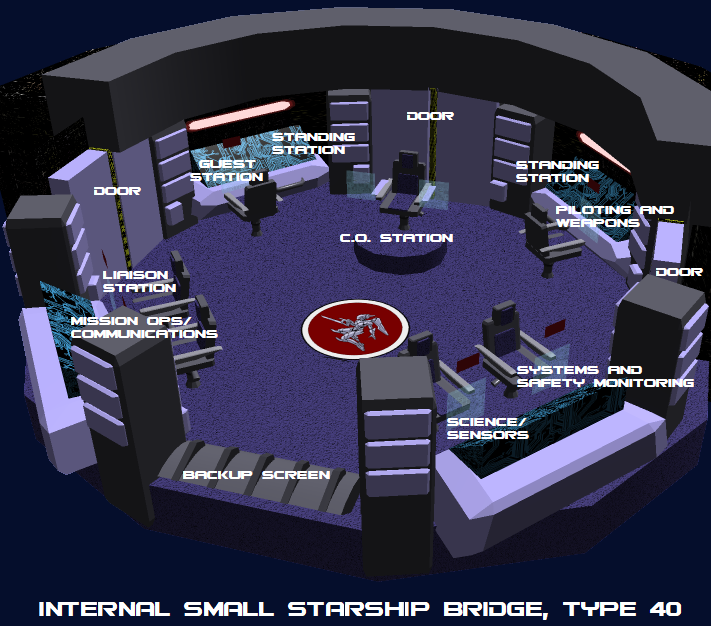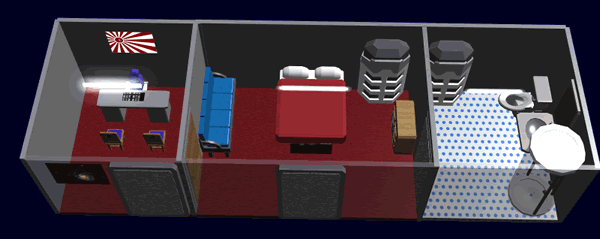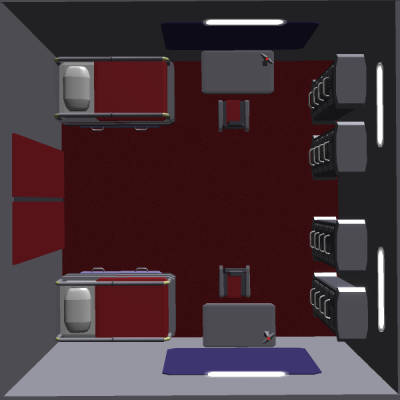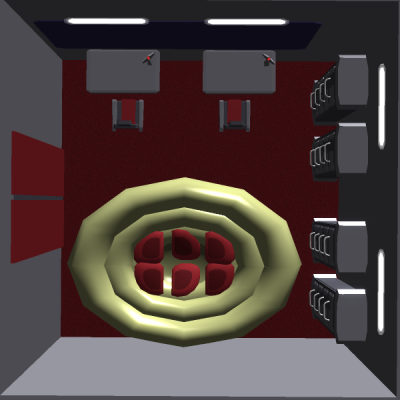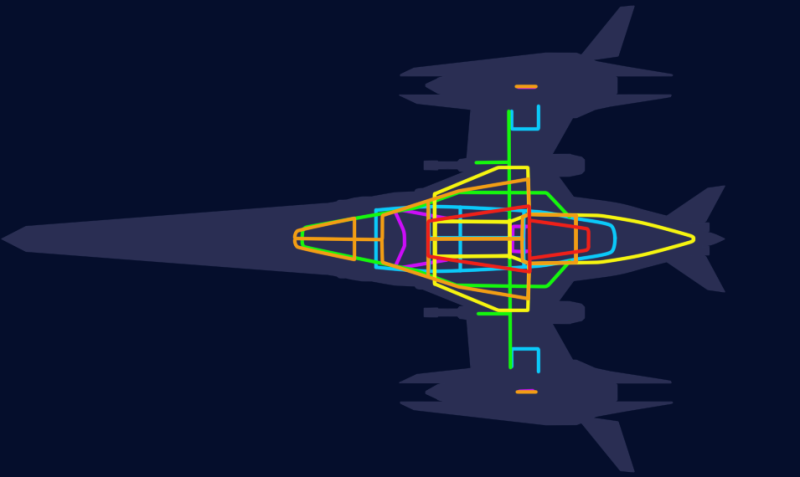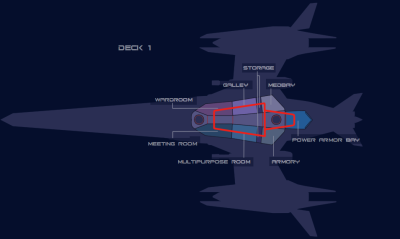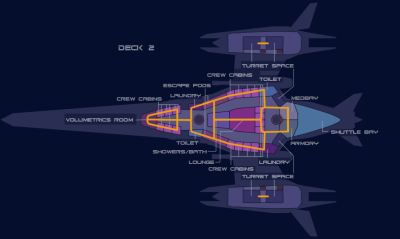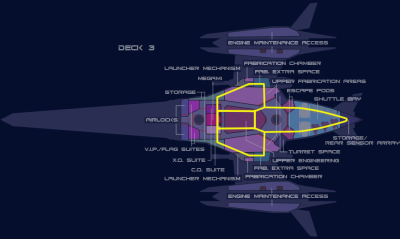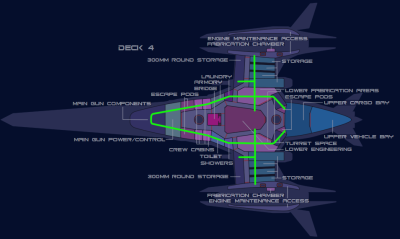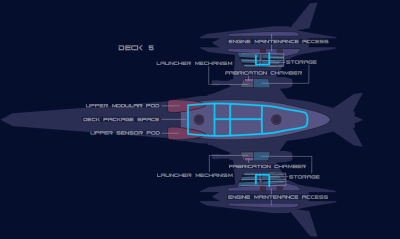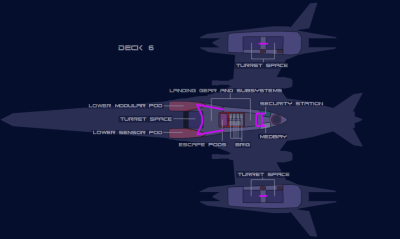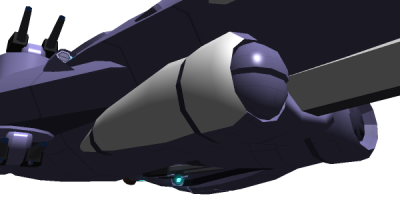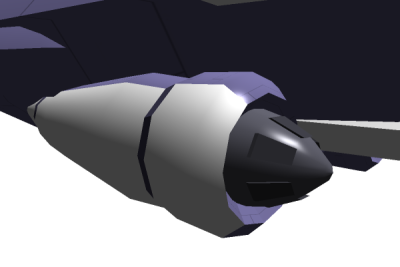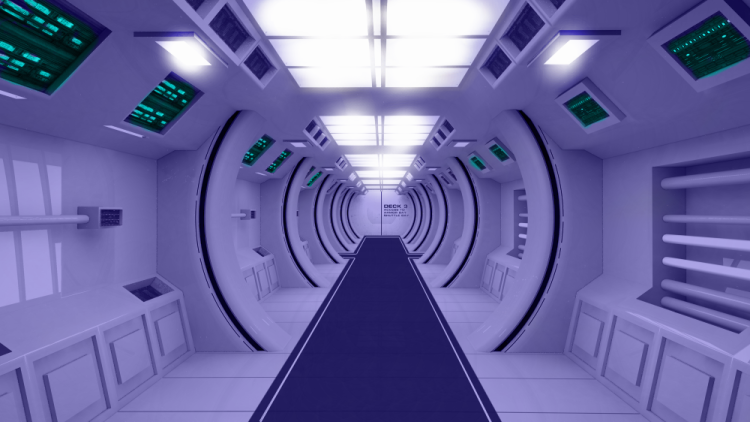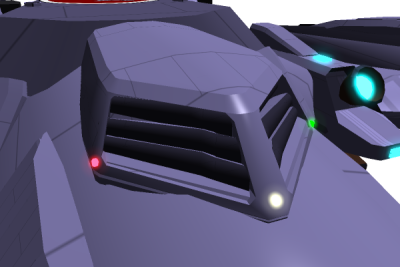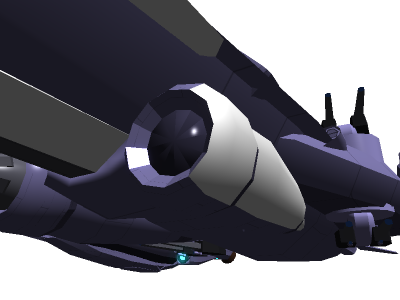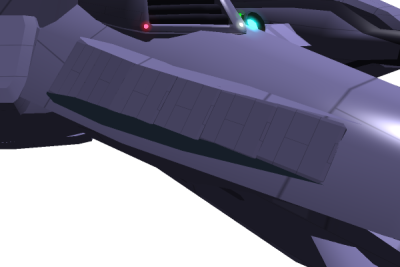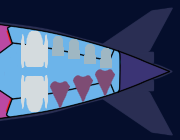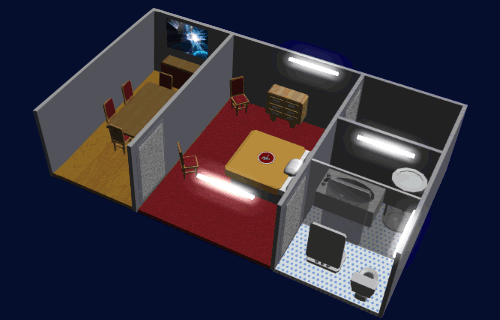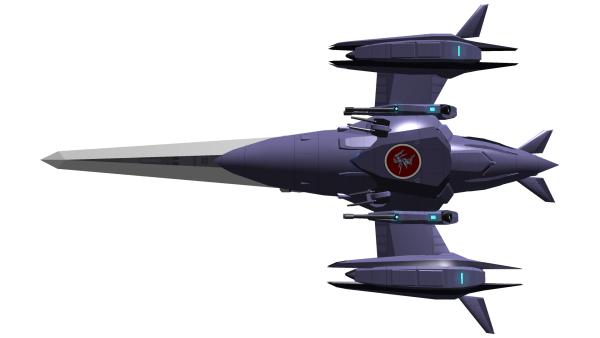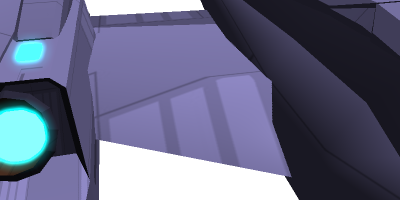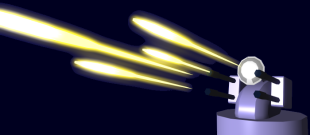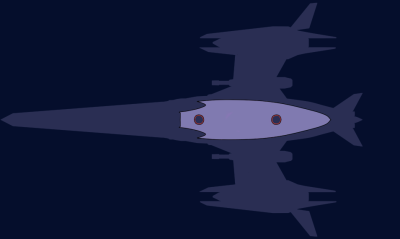Table of Contents
Plumeria-class (2E) Medium Gunship
The Plumeria is a high-performance interstellar gunship first manufactured in YE 29 by Ketsurui Fleet Yards for service in the Star Army of Yamatai. It has seen a great deal of success and a number of revisions through its service, including a comprehensive YE 40 “2E” refit.
About the Plumeria-class
The Ke-S3-2 series “Plumeria-class” is a YE 29 redesign of its similar, smaller predecessor, the Sakura-class Light Gunship. The Plumeria added increased cargo space, new weaponry, manufacturing, and defense systems with the Plumeria-class (2D) Medium Gunship. It is small, heavily armed, transports a large number of power armor for its size, and is quite fast like its predecessor. A major YE 40 “2E” refit improved the vessel's maneuverability, maximum compliment, storage capacity, secondary armament, point defense, structural durability, weapon integration, and general versatility.
Key Features
Plumeria-class ships feature top-tier FTL propulsion, a powerful main cannon, an array of retractable turrets, and powerful secondary weapons. Notable attributes include a Deck 5 dedicated to customization (which is used as a massive Cargo Bay expansion if not otherwise employed), an expanded Cargo Bay, a two-story Shuttle Bay with access through dual side doors, an independent Power Armor Bay, an expanded main body, dual Fabrication Areas, countermeasures including Electron Countermeasure systems and the Type 31 Electronic Warfare Suite, and powerful multi-mode thrust-vectoring STL propulsion built into the pylons and nacelles. The Plumeria-class Gunship also requires less maintenance and is more reliable than its predecessor, the Sakura-class Gunship1) and is equipped with self-repairing and replaceable segmented hull plates as part of its Integrated CFS Array for easier damage control.
Mission Specialization
The Plumeria was originally intended for a wide variety of mission profiles and autonomous operation, but specialized in seek and destroy missions against enemy warships and in supporting large-scale fleet warfare in an artillery role. Often, however, it had to prove itself in assorted other roles including patrol ship and interceptor. Some high-ranking members of the military have been known to use Plumeria gunships as personal transports throughout the class' history. Many also served in four-ship squadrons operating with small mobile starbases, in spite of being designed to function with small crews for up to a year without external support. The ship's 2E upgrade embraced these roles and increased the ship's attributes in assorted ways; including by increasing its armament, maneuverability, crew compliment, operating time, and even dedicating a whole deck to supplemental modification or upgrade. The Plumeria is a fine gunship and a 'jack of all trades' vessel, though specialized ships may be able to more efficiently carry out these supplementary roles.
Examples of the situations where the Plumeria can serve in a pinch are in its modest ability to transport VIPs or Flag Officers (though its two such rooms are inferior to the greater number on the Fuji-class Expeditionary Gunship), its ability to expand its functions through various Plumeria Deck Packages, and the same atmospheric combat options as the Chiaki-class (1B) Escort Destroyer (though the Chiaki has a smaller profile). The Plumeria also has a place for a second pod on the side for mission-specific, Plumeria Deck Package-specific, or CO-preferred hardware.
Appearance
Plumeria gunships have an elongated almond-shaped main body with two Ke-D7-M3900 Chiaki Pylon Modules on the sides which serve as structural supports for two wing-like pylons. These pylons each house a well-armored nacelle containing the primary STL propulsion system. The ship is covered in armored Integrated CFS Array panels and retractable turrets. From the front of the ship a massive dagger-shaped cannon array protrudes, accounting for nearly half of the ship's length and giving it a long, sharp figure. A smaller second spike is underneath the first, and to either side of that spike are pods – the one on the port side being a sensor array and the one on the starboard side being a swappable multi-purpose one. An expansion to the frame that gives more interior space gives the center underside of the ship a triangular shape. Some vessels have specialized hatches or structures on Deck 5 which are from of the assorted Plumeria Deck Packages available to customize the craft.
The hull color is typically Periwinkle, although some early models had light gray hulls and there are some decorated ships of note that carry their own custom colors. Many of these custom-colored vessels use the older light gray with a secondary color on the fins, pylons, and engines; having earned distinction as early models. Star Army Intelligence also uses a black-hulled version. For more pictures of assorted variants and examples of the class, see the Plumeria-class Art Gallery or the YSS Eucharis Art Gallery.
History
The S3 (Sakura) development project began under Acting Mistress Taisho Kessaku Irim in late YE 27 in the wake of the extremely costly Xyainbor System and Mwigflukbajik offensives against the Sfrarabla Mishhuvurthyar Xhrafuklurp (SMX). Irim made the design a “pet project” of hers and the prototype (affectionately named “YSS Swan”) was built in YE 28. Five test ship followed, serving active duty in the First Expeditionary Fleet. One of them, YSS Sakura (NG-X1-360, captained by Taisa Rufus Sydney and later by Taisa Ketsurui Hanako), would participate in an enormous number of battles and become so famous that after it was lost in combat, a museum was built to honor her.
After the Sakura's destruction, Hanako sought an improved version of the ship that had served her so well. Ketsurui Fleet Yards constructed the first of the new class, YSS Plumeria (NG-X1-390), in late YE 29 and Hanako used it to execute a daring and risky attack on the Sfrarabla Mishhuvurthyar Xhrafuklurp (SMX) headquarters. The design was so well-liked within the Star Army of Yamatai, that production of the Sakura-class Light Gunship for the First Expeditionary Fleet was halted in favor of the Plumeria series. By the end of YE 30, most Sakura had been disassembled and rebuilt as Plumeria; at that time, the Plumeria-class also saw a surge in new production as the Star Army added several new fleets to the roster.
By mid YE 31, the Second Mishhuvurthyar War was in full swing and starships were in short supply. Plumeria Gunships, now performing a wide range of missions, were upgraded to be more versatile and more heavily armed through addition of new systems, new engines, and external turrets. In this way they served through the war with distinction and continued to perform in various peacetime and wartime roles. By YE 39, no examples of the Sakura-class Light Gunship actively served; having been fully replaced by the Plumeria.
In YE 39, Kage Yaichiro sought to heavily upgrade the ship while optimizing its layout and point defense. He contacted command and crew of Plumeria, both current and former, to draw from their experience as well. The Ke-S3-3 series Fuji-class Expeditionary Gunship soon entered development and production independently, designed by one of the ship captains he had contacted, but its differing size and flight characteristics led Yaichiro to suspect that the ships could co-exist in overlapping but different roles because the Fuji functioned more like a cruiser. He pressed on, continuing to take his time to optimize and refine both this design and a revised Chiaki-class (1B) Escort Destroyer with increased parts commonality with the Plumeria.
This “S3-2E” program continued into YE 40 as an extensive review of every aspect of the Plumeria was conducted, the process taking an extended amount of time and resulting in the redesign and optimization of virtually every aspect and structural point of the vessel.
Notable Plumeria 2E Gunships
- YSS Sakura II, NG-X1-395, testbed of the 2E refit. Prevented an nanite weapon from being spread by a rogue Star Army Intelligence cell. It also discovered and visited an alternate universe. Named for the famous YSS Sakura.
- YSS Aeon II, NG-X1-409A, replacing the original Aeon.
Statistics and Performance
The Plumeria-class is a very fast ship with an optimized internal layout. She has notable firepower, maximum compliment, and vehicle carrying capacity for her size. The thrust vectoring capability of her engines also grants her maneuverability normally reserved for smaller vessels like the Sakura-class Light Gunship.
General
- Class: Ke-S3-2E series Plumeria
- Type: Nekovalkyrja Medium Gunship
- Manufacturer: Gemini Star Fortress
- Fielded by: Star Army of Yamatai
Passengers
Crew: 3 operators are recommended on the Bridge with only 1 required, though it can hold up to 9. There are typical accommodations for between 47 and 91 people, though the lower number is the more standard crew compliment for the vessel. Plumeria Deck Packages can alter these numbers by adding more provisions for crew.
Maximum Capacity: 213 people can live aboard the vessel when every bed is filled, but the ship's ability to sustain that many people long term would be tested. The vessel's six Star Army Fabrication Chamber, Type 39s can be used to feed 180 extra people regularly in this situation or produce simplified rations for more, as well as help process waste and supplement life support systems. The standard Escape Pod occupancy for the Plumeria is 285 (five per pod), but its absolute maximum is 399 (seven per pod). The Plumeria, in cases where short term evacuation and transport is needed where people do not need to use its facilities and resources, can hold approximately 3,000 people for a few hours due to its large storage capacity without employing stasis. In such cases, distributing rations and field-based toiletry options is highly recommended. Plumeria Deck Packages can change all of these attributes.
| Quarters Type | Number | Standard Crew | Expanded Crew | Maximum Crew1 | Full Occupancy1 |
|---|---|---|---|---|---|
| Crew Cabins | 22 | 44 | 88 | 132 | 132 |
| V.I.P. Suite | 2 | usually 2 beds total, not counted toward crew total | 4 | ||
| MEGAMI | 1 | 1 | 1 | 1 | 2 |
| X.O. Suite | 1 | 1 | 1 | 1 | 2 |
| C.O. Suite | 1 | 1 | 1 | 1 | 2 |
| Medbay | 3 | 51 beds total, not counted toward crew total | 51 | ||
| Small Brig | 4 | usually 4 beds total, not counted toward crew total | 8 | ||
| Large Brig | 1 | usually 6 beds total, not counted toward crew total | 12 | ||
| Total | 47 | 91 | 135 | 213 | |
1Additional people can fit in various configurations with the use the Star Army Nekovalkyrja Nest/Life Raft, Type 40 instead of a bed or the use of the Star Army Bunk Bed, Type 40 set to 3 bunks high. This, however, is not considered normal compliment. This also does not include modifications to Deck 5 via Plumeria Deck Packages.
| Crew Type | Recommended Number |
|---|---|
| Night Bridge Shift | 2 |
| Day Bridge Shift | 3-6 |
| Officers | 5-8 |
| Engineers/Technicians | 2-6 |
| Infantry | 8-17 |
| Medics | 3-6 |
| Supply | 1-3 |
| Cooks | 1-3 |
| VIP | 0-4 |
| Total3 | 19-47 |
3As Night and Day Bridge Shifts are counted under Officers, they are not counted twice in the Total. This number may also change based on specific Plumeria Deck Packages.
Dimensions
- Length: 254 meters (833.33 feet)
- Width: 163.7 meters (537.07 feet), 130.7 meters (428.74 feet) with nacelle wings folded up
- Height: 26.25 meters (86.12 feet), 31.5 meters (103.35 feet) with turrets out
- Decks: 6 (Deck 4 is 6.25 meters, others are 4 meters each)
Where it Fits
- The main repair bay of an Anri-Class Deep-Space Repair Vessel or an Ikoi-Class Light Starbase can hold up to 10 Plumeria Gunships.
- Up to 8 Plumeria Gunships can dock at a Kisaki-class Starbase.
- An Iori-Class Star Fortress construction bay can hold approximately 2,880 Plumeria Gunships. If all sixteen bays are used, that's 46,080!
- Frontier Starport bays can hold 10 Plumeria Gunships easily with slight staggering, or 15 with additional care in placement.
Propulsion and Range
-
- Minimum: Resting motionless
- Cruising Speed: 18,750c (~2.14 light-years per hour)
- Maximum Speed: 21,915c (2.5 light-years per hour - This speed is a military secret.)
- Hyperspace Fold Drive: 525,960c (1 light-year per minute/60 LY per hour)
-
- Atmospheric Speed (Prop): 864 kilometers per hour (537 mph/Mach 0.7)
- Atmospheric Speed (Jet): 6174 kilometers per hour (3836 mph/Mach 5)
- Water Speed (Magnetic without shields): 200 kilometers per hour (108 knots) at Yamatai's sea level
- Water Speed (Magnetic with shields): 800 kilometers per hour (430 knots) at Yamatai's sea level
- Orbital Sublight Speed: 0.05c (~14,990 kilometers per second)
- Sublight Speed on Pylon Engines Only: 0.250c (~74,948 kilometers per second)
- Maximum Sublight Speed: 0.375c (~112,422 kilometers per second)
- Range: Theoretically unlimited
- Lifespan: Estimated 20 years of constant use, although this could certainly be extended. The 2E refit readies this ship for 20 more years of service.
- Refit Cycle: Frequent minor updates through the PANTHEON system and a refit once every five years.
The Plumeria is an exceptionally fast vessel capable of travel through air, water, space, heavy non-combustible mediums, and heavy magnetic mediums like water. It is also capable of thrust vectoring. See Star Army of Yamatai Starship Speeds for a comparison of the Plumeria's speeds with other ships of the Star Army of Yamatai.
Damage Capacity
See Damage Rating (Version 3) for an explanation of the damage system.
- Tier: 11, (Medium Starship)
Inside the Plumeria Gunship
The Plumeria's interior is carefully planned and arranged, having a complexity and redundancy greater than that of many other vessels. The deck plans, rooms, blast shutters, and maintenance conduits are rather complex for a vessel of its size because of this. Deck 5's layout looks sparse due to the capacity for installing Plumeria Deck Packages.
Deck Layout
Please note that the red lines are not doors, but rather the locations of Zesuaium Blast Shutters.
| Deck | Compartments |
|---|---|
| 1 | Armory, Galley, Medbay, Meeting Room, Multipurpose Room, Power Armor Bay, Storage, Wardroom |
| 2 | Armory, Crew Cabins, Escape Pods, Laundry Rooms, Lounge, Medbay, Showers/Bath, Shuttle Bay (Upper), Toilets, Turret Space, Volumetrics Room |
| 3 | Airlocks, C.O. Suite, Engine Maintenance Access, Engineering (Upper), Escape Pods, Fabrication Areas (Upper), Fabrication Chambers, Fabrication Extra Space, Launcher Mechanism, MEGAMI, Rear Sensor , Shuttle Bay (Lower), Storage, Turret Space, V.I.P./Flag Suites, X.O. Suite |
| 4 | 300mm Round Storage, Armory, Bridge, Cargo Bay (Upper), Crew Cabins, Engine Maintenance Access, Engineering (Lower), Escape Pods, Fabrication Areas (Lower), Fabrication Chambers, Laundry Rooms, Main Gun Components, Main Gun Power/Control, Showers, Storage, Toilets, Turret Space, Vehicle Bay (Upper) |
| 5 | Plumeria Deck Package Space, Engine Maintenance Access, Fabrication Chambers, Launcher Mechanism, Modular Pod (Upper), Sensor Pod (Upper), Storage |
| 6 | Brig, Escape Pods, Landing Gear and Subsystems, Medbay, Modular Pod (Lower), Security Station, Sensor Pod (Lower), Turret Space |
Compartments
All rooms in the Plumeria-class gunship have phones and firefighting stations. They also all have at least 33cm of bulkhead in place for walls and some are able to be sealed by Zesuaium Blast Shutters.
300mm Round Storage (2)
On Deck 4, specifically in the leading edges of the pylons, storage areas allocated to storing a combined 4,800 300mm Mass Launcher Rounds exist. These are the rounds used in the Ke-D7-W3900 Mass Launchers which are located in the Ke-D7-M3900 Chiaki Pylon Modules. They are often replenished between battles by the Star Army Fabrication Chamber, Type 39s which also reside in these pylons. Loading and arranging is done by a Scalable Graviton Beam Projector Array in each pylon.
Airlocks (2)
The Airlocks are halfway between Decks 2 and 3, but they feed into the vessel on Deck 3 beyond supplemental protective blast shutters. There is one on each side of the ship, just behind the main gun's systems. The Airlocks are retractable and cannot be easily used if retracted. Both Airlocks also have an extra-long, extending flexible docking tube with an automatically adjusting end connector that is able to connect to nearly any other ship's airlock.
When the Plumeria's Shuttle Bay capacity is being taxed, it is possible to dock a Raccoon T7 on each airlock. This method is sometimes employed when transporting temporary supplements to crew and vehicles.
Armories (3)
Located on assorted decks, the Armories serve various purposes. All are Zesuaium-armored, static-free vaults with independent environmental systems and no access to the Nodal System. They can all be used as panic rooms or emergency shelters and can only be accessed by those to whom the ship's CO has granted access. Beyond this, however, they serve in different roles which are defined by the area in which they are located.
- Deck 1 – Serves all Power Armor and has direct access to the Power Armor Bay.
- Deck 2 – Main Armory, also has direct Shuttle Bay access. Serves shuttles, fighters, and provides normal armaments for the crew.
- Deck 4 – Near the Bridge, Engineering, and the Crew Cabins. Stocked mainly with weapons intended for protecting the interior of the vessel.
Bridge
Found on Deck 4, the Star Army Internal Small Starship Bridge, Type 40 serves as the heart of the vessel. It is notable for being well within the vessel rather than being near the exterior where it can be attacked. The Bridge also cannot be accessed except by those who have permission from the Commanding Officer, and has three doors with blast shutters that can restrict access. In spite of this, it has ready access to important features. The Bridge has 7 seated stations including that of the CO, 2 standing stations, and the ability to employ volumetric projections over almost every surface and space within. It can also use force fields to restrain or partially mitigate weapons damage from hostiles.
The side doors lead out into Deck 4's corridors near the officers' Crew Cabins and Escape Pods, while the rear door accesses another Deck 4 corridor as well as two small Zero-G Passageways. These passageways go to the CO's Quarters, XO's Quarters, and MEGAMI on Deck 3 as well as to more Escape Pods in the Subdeck and even Deck 5 if such options are installed. Because of this, there are a number of evacuation routes to compensate for the Bridge's location in the heart of the ship and it can be rapidly staffed in a combat situation.
Brig
The Brig is a complex of rooms and a small corridor on Deck 6 which is intended for the storage of inmates. The only ways out of the complex are a door in view of the Security Station, and the door to the Deck 6 Escape Pods which can be remotely opened. The entire complex is surrounded by meter-thick Zesuaium and jamming devices, has its own environmental systems, and is monitored from the Security Station outside. All of the rooms house normal bunkbeds and have basic showers and toilets, as well as a sliding hatch in the door for providing food and drink and claiming used trays. Four 4m x 2m x 2m rooms are meant for single or dual occupancy and are meant for more violent inmates, while the larger 7m x 4m x 2m room has six bunk beds, housing a dozen people. The total occupancy of the Brig is 20 people.
The reason for the inclusion of the Brig can be traced all the way back to the Sakura-class Light Gunship, which was compact and repeatedly stored its prisoners in the Medbay due to a lack of alternatives.
C.O. Suite
The C.O. Suite on Deck 3 of the Plumeria-class is based on the a Star Army Standard Captain's Suite, though with 2 meters more width in its office, bedroom, and bathroom. As a result, the rooms are larger with the bathroom having a jacuzzi installed and a measure of other customizations possible within the added space. It also has two doors from outside to the office, and no access from outside to the C.O.'s bedchambers. One door leads to a Deck 3 corridor, while another leads to the a Zero-G passageway to the Bridge and further to the Subdeck's (and if present, Deck 5's) Escape Pods as well as directly to a the MEGAMI. It is the same as the X.O. Suite, aside from being mirrored.
Cargo Bay
Located on Deck 4 at 6.25 meters tall, and often extending into Deck 5 for an additional 4 meters in height depending on the Plumeria Deck Package employed, the Cargo Bay has white padded walls, white and red interior lights, and a metal floor with plenty of tie-down points and strips of rollers. It also has power hookups so that power sources built into cargo containers can be slaved to the ship's power distribution system for backup power. In addition to a Scalable Graviton Beam Projector Array, each end of the Cargo Bay has a large robotic arm that extends from the ceiling area. It can be manually operated via a mobile control console, or (by placing the console on automatic mode) operated by the ship's computer via voice command. The crane goes far enough back that it can slide out into the Vehicle Bay and sit over the bottom of the cargo ramp.
The Cargo Bay can hold between 12 and 18 Type 33 Prefab Modules/Collapsible Rapid Deployment Modules, or between 16 and 22 SSCC-XL when properly stacked. Unlike earlier revisions, the Cargo Bay does not count the Vehicle Bay in its storage capacity due to a more clear division between the two. It is possible to carry between 2 and 4 SSCC-Huge by leaving the massive force field-capable doors between the Cargo Bay and Vehicle Bay open and letting the containers stick out into the Vehicle Bay. If needed, the Vehicle Bay itself could be used as a secondary Cargo Bay, as sometimes done on the Sakura and previous Plumeria. It is also possible to move the large 15 meter long containers through the ship into storage in the pylons, which can be used to further supplement the Cargo Bay. If a Plumeria Deck Package is not installed, the Cargo Bay is at its maximum dimensions and expands into the Plumeria Deck Package Space. This results in a Cargo Bay that contains the near-entirety of Deck 5 within the body of the ship, as well as the typical parts of Deck 4.
Of course, the Cargo Bay is not a personal storage (or sparring) area for the crew. There are plenty of other places to handle such activities.
Crew Cabins (22)
Aboard the Plumeria, 22 Star Army Large Crew Cabin, Type 40 can be found. There are 18 for normal crew on Deck 2, and 4 for Officers and the Chief Engineer on Deck 4. It should be noted that the dimensions of the rooms may vary slightly due to deck geometry, but no side of the room aside from its height is under 5 meters in length. Many are either 5m x 7m or 6m x 6m. The height of the Cabins on the Plumeria are 2.75 meters on Deck 2 and 3.0 meters on Deck 4.
The rooms can employ Star Army Bunk Bed, Type 40 or the Star Army Nekovalkyrja Nest/Life Raft, Type 40 to house anywhere from 1 to 6 people, though 2 and 4 person configurations are the most common. It is not uncommon to fold up a bunkbed and a desk and stow them along a wall if the room is occupied by only a single person, or to find a Cabin with single nest in which all of the ship's Miniature Nekovalkyrja sleep. Each room also has four lockers along the back and two desks, as well as Volumetric Windows which also provide the room's lighting.
Deck Package Space
This 90 meter by 25 meter by 4 meter space, which runs through the ship's body and narrows as it approaches the large vehicle ramp at the rear, is dedicated to the use of Plumeria Deck Packages. It is largely a vacant space which can also connect to the Modular Pod and Sensor Pod. It is possible to remove hull panels more readily from the inside of this section for the purposes of installing hangar doors or airlocks, though this cannot be done without very specific instructions from the bridge. It is designed to have components easily installed and to add a customized layout to the deck with maximum efficiency and structural integrity. The Vehicle Bay Door/Ramp employs force fields to prevent decompression.
When not using a Deck Package and configured to its default state, the area is a supplemental storage space which has direct access to and is a direct expansion of the Cargo Bay. This includes white padded walls, white and red interior lights, power hookups, overhead cranes, and a metal floor with plenty of tie-down points and strips of rollers. The capacity of the Plumeria, when in this configuration, is enormous and capable of holding many SSCC-Huge. A lack of a Plumeria Deck Package also makes the Cargo Bay and Vehicle Bay at the rear of the ship two decks tall.
Engine Maintenance Access (2)
Located in the main engine nacelles on Decks 3, 4, and 5 are three-deck-high maintenance corridors. They exist on either side of the engines for the purposes of easy maintenance and are connected to small zero gravity hatches that go through the decks to the tops and bottoms of the engine on Decks 2 and 6 respectively.
Engineering
Engineering is located in the middle of the ship on Decks 3 and 4 to protect it from damage, in hopes of minimizing power disruptions or fatal damage to the ship in combat. It also takes advantage of the Subdeck under Deck 4 to connect to the main gun's power systems and components without interfering with corridors, and also to connect to the STL engines through the pylons via the same deck. Engineering is crowded with loud, tightly-packed machinery and systems. A catwalk runs around the room on Deck 3 in place of a floor. The Aether power generator here is the most prominent feature, set into the center of the room. The hyperspace unit is another one of the larger systems found inside. There are fusion reactors (for secondary power), liquid coolant systems, and a number of maintenance conduits that can be entered from Engineering. Engineering also contains 8 Damage Control Stations, with 4 per deck.
Maintenance Guidelines
- Aether generator's Zesuaium internal panels should be replaced every 6 months.
- Fusion generators should be occasionally replaced
- Capacitors should be inspected every month and after battle.
- Most equipment on the ship is self-cooling, but major power lines use a liquid coolant system. Check for leaky fittings.
Escape Pods (57)
Located on all Decks but Deck 1, these areas store a total of 57 of the space-efficient Star Army Escape Pod, Type 35 "Seizonsha". As these Escape Pods can hold up to 285 people in normal operation, or 399 in an emergency, there are more than enough Escape Pods for the ship's entire compliment. It is possible to omit some Escape Pods and use partial occupancy for the other decks, provided the Escape Pod occupancy never dips below the ship's current compliment, though this is rare as launching empty pods that deploy in assorted directions can buy additional time for occupied pods to escape. Escape Pod areas which are not filled with Escape Pods may become additional storage space.
- Deck 2 - 2 locations with 12 pods each near the Crew Cabins
- Deck 3 - 2 locations with 5 pods each near the Shuttle Bay
- Deck 4 - 2 locations with 8 pods each near the Crew Cabins, 2 locations with 2 pods each near turrets
- Subdeck – 2 locations with 2 pods each under and to the sides of the Bridge
- Deck 6 – 3 pods near the Brig
Due to the height of the Escape Pod being slightly taller than one deck, these spaces can slightly intrude into adjacent decks slightly but in exchange can be stored and launched in a vertical orientation for increased quantity. Exceptions to this are Deck 4 and the Subdeck, which stores Escape Pods horizontally due to the different deck height for more efficient stacking and allows the other decks' Escape Pod areas to intrude upon that deck without consequence. Deck 5 may add to this number if a Plumeria Deck Package is employed that has Escape Pods. It should be noted that in addition to launching Escape Pods, these areas also launch hundreds of inflatable 'dummy' pods which are designed to overwhelm an enemy with targets which fly out in all directions while also providing false sensor readings. These dummy pods appear both in Escape Pod and SS Pod variants. The ship's Type 31 Electronic Warfare Suite may be able to achieve the same effect, but the dummy pods persist if the vessel has been disabled or destroyed and can beyond the suite's range limits.
Soul Savior Pod
Stored and launched from an Escape Pod area of the CO's choosing, the ship's Soul Savior Pod can be launched by itself or while inside a Star Army Escape Pod, Type 35 "Seizonsha" if that is the preference of the CO. While the use of an Escape Pod for this task risks easier detection by an enemy, it does allow the Soul Savior Pod to be transported at faster-than-light speed away from the vessel if launched while in interstellar space.
Fabrication Areas (2)
The Plumeria Gunship carries 2 two-deck-tall areas on either side of Engineering on Decks 3 and 4 that are dedicated to construction. These chambers contains robotic arms, nanomachine colonies, matter-to-energy converters and refiners, and other implements of industrial construction. The gunship is capable of building items such as power armor, vehicles, and torpedoes (but not organic materials) up to a Ke-T7 "Raccoon" Transport Shuttle in size without having to collect external resources. Larger and/or more complex items take longer amounts of time to fabricate. Larger items may require the Fabrication Extra Space in the Ke-D7-M3900 Chiaki Pylon Modules on Deck 3 or the storage area in Deck 4 to fit, though this is usually partitioned off to avoid decompression in the case of damage to or removal of the Module.
It should be noted that it is possible to move a Ke-T7 "Raccoon" Transport Shuttle all the way from the Shuttle Bay to the Fabrication Bay through the ship's interior on Deck 3, and Type 33 Prefab Modules or Collapsible Rapid Deployment Modules from the Cargo Bay through the ship and Fabrication Area to the storage in the pylons on Deck 4. As such, the largest items the Fabrication Area is likely to produce or repair can be moved through the vessel without needing to be disassembled, with the possible exception of the Ke-V10 "Mamushi" Multirole Starfighter.
Fabrication Chambers (6)
Located in the Ke-D7-M3900 Chiaki Pylon Modules on Decks 3 and 5 and in the nacelles near Deck 4's Engineering Maintenance Access; these Star Army Fabrication Chambers, Type 39 are used to construct 300mm Mass Launcher Rounds for the nearby Ke-D7-W3900 Mass Launchers as well as assorted Power Armor and components. They differ from the Fabrication Areas in that they can also work with organic matter and can help make food and rations for the crew if necessary to supplement the Galley. Each of the 6 chambers can feed 30 people regular meals, for a total of 180. Any more people would strain the system, requiring the creation of simplified rations instead.
Fabrication Extra Space (2)
This is extra space in Deck 3 corresponding to the Ke-D7-M3900 Chiaki Pylon Modules which can be opened up to the Fabrication Bays. It is often sealed or used for storage in case of decompression of the Pylon Module in combat, and only opened to the Fabrication Area when a large structure such as a Ke-T7 "Raccoon" Transport Shuttle needs to be constructed and assembled.
Galley
Located in Deck 1 off the Wardroom, the Galley has been expanded into its own area with a built-in Scullery. This has been necessitated to help with the increased crew compliment and the enlarged Wardroom. It is also better stocked with spices and other such options to cater to a wider palette, including any VIPs being transported. It also includes a multi-layer hydroponics system used to grow spinach, tomatoes, basil, and other herbs and vegetables. This helps the ship maintain a supply of quality ingredients when away from ports, much like that employed on the YSS Eucharis even before the existence of the 2E variant.
Landing Gear and Subsystems
Found on Deck 6, these systems consist of assorted minutia in addition to the landing gear. The landing gear has been redesigned to allow the ship to remain more stable given its structural improvements and weight distribution changes. The relocation of Engineering to the middle of the ship has improved the vessel's balance, and it is no longer necessary to use anti-gravity systems to support the main gun when landed.
Launcher Mechanisms (4)
On Decks 3 and 5, specificly in the Ke-D7-M3900 Chiaki Pylon Modules, mechanisms for the Ke-D7-W3900 Mass Launchers can be found. The purpose of these is to fire 300mm Mass Launcher Rounds. Each is located next to a Star Army Fabrication Chamber, Type 39, and is also fed by the 300mm Round Storage in the pylons on Deck 4.
Laundry Rooms (2)
On Decks 2 and 4 are variants of Standard Star Army Laundry Rooms. Though the Laundry Room of Deck 2 has 10 washers and 10 dryers, being two of these rooms married together, Deck 4's is reduced to 3 washers and 3 dryers.
Lounge
The Plumeria has a Lounge on Deck 2, which is home to the traditional Dare Lottery Party and is meant to be the social heart of the ship. It is extremely comfortable and centrally located among the Crew Cabins with a staircase that leads up to the Wardroom, and also has two curtain-covered doorways that lead to the Showers/Bath.
It has Volumetric Windows for the walls and ceiling which can change color (typically red) and a floor that is thickly carpeted in a shaggy red carpet with the design of the Star Army Hinomaru in the center. The Lounge also has a bunch of bolted-down furniture like soft leather couches and coffee tables running around the edges of the room. Lamps on some of the tables and in a circle around the ceiling provide soft, white lighting, focusing on the open area in the middle corresponding with the Hinomaru. A small nook located off to the side contains a Coffee maker, icemaker, microwave, mini-fridge, and a small drink bar. Note that the Lounge is not a dining area. The mini-fridge is used for drinks and small snacks only, and is labeled as such.
Main Gun Components
The Main Gun's assorted systems span the front of the ship, but are most accessible from the Main Gun Power/Control area on Deck 4. Connections between the Engines, Engineering, Main Gun Power/Control, and the Main Gun itself are conducted through various interfaces and buffers in the Subdeck that makes up the bottom of Deck 4. This replaces the Main Cannon Junction from previous versions of the vessel.
Near the door to the Main Gun Power/Control is a large warning notice cautioning about the dangers of vaporization. A round gray manual shutoff switch with a hand-sized rubberized grip bar across it is on the other side, with a small panel that reads DISABLED in green or ENABLED in red. Below, a notice declares, “By order of the Star Army, this room must be visually inspected to ensure there are no crew members present before the main cannon system is re-enabled. Failure to do so could result in death. Never turn this switch if the main cannon is not fully assembled.” A hatch in the floor leads down to the maintenance tunnel for the lower main cannon assembly.
Main Gun Power/Control
The Main Gun Power/Control Room on Deck 4 is similar to the Power System room in previous offerings of the ship, in that it holds capacitors and energy charging devices intended for use with the Main Gun. It is heavily armored and it is typically locked from conventional access with a large blast shutter.
The systems within the room are designed explicitly not to back-flow into the Engineering area it draws power from, and are otherwise decoupled from the remainder of the vessel. In cases where the capacitors are damaged and are about to explode, they can be ejected from the ship much like Escape Pods. An enterprising CO may elect to weaponize this functionality in a pinch.
Maintenance Conduits
Various small tunnels run throughout the ship, ribbed with support framing and lined with pipes and wiring. These allow access to some of the ship's more remote areas. They have minimal gravity and are usually quite loud inside, due to the vast amounts of electrical systems present in the Plumeria Gunship. The complex nature of the starship means technicians will have to visit these conduits every so often to keep the ship in top working order, especially after intense battles. With the 2E Upgrade, the maintenance conduits have taken on an exponential increase in complexity but allow for technicians to more quickly access more systems.
Medbays (3)
The Medbays of the Plumeria are based on the Sakura-type Medical Laboratory but are heavily expanded upon and are positioned to cater to various purposes. All beds have both force field and physical restraints that can be used if necessary. It should be noted that the Plumeria has a Brig, so the specimen containment rooms can be used for their intended purposes or as recovery rooms to free up beds for new patients.
- Deck 1 – Connected to Power Armor Bay and serves it directly. Has triple the capacity of the Sakura-type Medical Laboratory.
- Deck 2 – Main Medbay, also connected to Shuttle Bay and serves it directly. Has triple the capacity of the Sakura-type Medical Laboratory.
- Deck 6 – Compact version near the Security Station that serves prisoners from the Brig. Has two beds, two hemosynthesis tubes, one Medical Scanner Charging Station, and one room for both examination/operation in which backups are also conducted.
The Plumeria's medical facilities have a total of 20 Hemosynthetic Reconstruction Tubes, 20 beds for treatment, 7 rooms for examination/operation, 6 mental backup centers, 18 specimen containment rooms, 8 Medical Scanner Charging Stations, and up to 24 Portable Medical Scanner PMS-1Ms (plus 4 Portable Medical Scanner PMS-1C for the Medbay on Deck 6).
MEGAMI
This room on Deck 3, located directly above the Bridge and between the C.O. and X.O. Suites, contains the core of the MEGAMI Integrated Electronics System. It is normally inaccessible except to the ship's CO, XO (if the CO permits), and certified technicians. It is protected by armored walls and closed blast shutters.
This area is designed much like a Star Army Standard Captain's Suite with stretched dimensions and the office replaced with a far larger room lined with various access panels, control panels, and displays. The bedroom has a bed for the ship's avatar which can be used while the lid for it is open or shut, and a generator system which powers the mainframe. It is a more comfortable bed than previous systems have employed. Her bathroom also has a jacuzzi, like those of the C.O. and X.O. These changes reflect the more modern idea that the MEGAMI is as much a member of the crew as she is the ship's computer. The MEGAMI's avatar is also encouraged to escape via an Escape Pod if possible in a situation where the ship cannot survive, or at least to contribute her own data to the ship's Soul Savior Pod.
Meeting Room
The Meeting Room on Deck 1 is intended as a briefing and debriefing area for Officers or V.I.P.s, though it is also used for things like weddings, memorials, and speeches. It is designed to seat the entirety of the ship's compliment if needed. Bench-style seating fills the room with the fore end occupied by the speaker on a meter-high elevated platform, with volumetric projectors in the walls, ceiling, and floor assisting any speaker in their work while also allowing the room to be decorated in whatever form is proper for the topic of discussion. It is possible to retract the speaker's platform and fold down the bench seating into the floor, to use the Meeting Room as another Volumetrics Room or for other purposes defined by the CO. If the crew is small, it can be used as another storage room as the Wardroom is sufficient for smaller gatherings.
Modular Pod
Located on Decks 5 and 6, but only accessible from Deck 5, is the Modular Pod. It mirrors the Sensor Pod, but can be detached from the ship and serve a myriad of functions by being replaced with other pods. While the default pod is used just for additional storage or vehicles, there are many possible variants with assorted purposes.
Multipurpose Room
Located on Deck 1, the Multipurpose Room is much like the Recreation Area in earlier revisions of the ship in function. It is devoted to sparring and exercise primarily, though it also has provisions to allow it to act as a Volumetrics Room. Included in the equipment for this room are two Ke-J1-E3105 - Autonomous Massage Unit (AMU) mirroring those on the YSS Eucharis.
Passageways
Plumeria gunships use Standard Passageways and Standard Star Army Zero-Gravity Passageways (the main vertical passageways). These passageways run through the decks of the ship vertically as well as horizontally, and are approximately 3 meters in diameter at the smallest. The Zero-Gravity Passageways are 7 meters across and double as cargo lifts. Eating or drinking in the passageways is forbidden.
Some of these passageways on Decks 3 and 4 are quite massive at the rear of the ship; so as to move vehicles, cargo, fighters, and shuttles through between the assorted bays and the Fabrication Areas.
Rear Sensor
The Rear Sensor on Deck 3 at the rear of the ship is a smaller sensor system based on the larger Sensor Pod and intended to supplement it. It can scan targets above, below, and behind the vessel; including those being towed by the ship.
Power Armor Bay
Located at the rear of Deck 1, with direct Medbay and Armory access, the Power Armor Bay is a two-door structure formerly reserved for a secondary engine system on pre-2E variants of the Plumeria. Green, white, and red running lights can be seen on the exterior of the Power Armor Bay to assist approaching Power Armor attempting to land. It is able to hold a maximum of 5 rows of Power Armor racks compatible with the assorted units employed by the Star Army of Yamatai, 3 rows of which are two sided racks; resulting in 2 rows of 13 PA, 4 of 15 PA, and 2 of 17 PA with just shy of two meters of walking room between each row of racks. It has a maximum occupancy of 120 Power Armor while leaving some room near the two doors for launch space, though this occupancy may be reduced to as low as 90 if Kirie Thought Armor or Keiko Thought Armor are exclusively employed.
The middle racks can be pushed together, rotated, and pushed against the ceiling to save space when not in use, which is the typical arrangement when not employing supplemental Star Army Infantry beyond the ship's standard compliment. In this mode, the Power Armor Bay can support 26 Power Armor stored along the sides of the bay. It is also possible to use the bay to support two Ke-V6-2A "Hayabusa II" Starfighters in this configuration if desired. It should be noted that the room has force fields to prevent decompression and graviton beam projectors to help with the manipulation or guidance of adrift objects.
Security Station
Located on Deck 6, the Security Station is typically only manned when there are prisoners in the Brig. An armed crew member must stand guard at this station in such an instance, managing the doors and providing meals and clothing. They are also responsible for responding to calls, breaking up fights, activating defense measures like the use of knock out gas or other atmospheric controls, and providing access to the Escape Pods for the prisoners if needed.
The station has a full view of the Brig's sole exit through a Volumetric Window mounted on an armored wall. It also has ports through which the soldier can fire their sidearm if need be. There are also assorted screens showing the contents of each cell and the corridor, as well as the Escape Pod area. There is also a direct line to the Bridge.
Sensor Pod
A somewhat cramped compartment inside the sensor dome is accessible via Deck 5 or via maintenance conduits, though it is typically sealed off except to technicians or command staff. It is not accessible via Deck 6, though it technically also exists on it on the deck plan. Inside of the dome are rings of delicate sensors. The entrance to the compartment is an old-school round hatch with a wheel-style locking system. The front end of the dome is transparent, but mostly obscured by sensor machinery.
Showers, Communal (15)
Deck 4 is equipped with Communal Showers. These are for use by officers living in the Crew Cabins on Deck 4. Deck 2 has a separate facility for cleanliness. These do not have panels separating them, nor are they gender specific.
There are three rows of showers, with 4, 5, and 6 Showers each for 15 total.Every row has a clearly marked locker where one can place their laundry while they strip, bathe, and re-clothe themselves. Of course, there is nothing stopping anyone from bathing in whichever facility they wish.
Showers/Bath, Communal
Deck 2 has a specific area for the crew to bathe and mingle just off of the Lounge, emphasizing social gathering. Two entrances on the aft side of the area exist with curtains over them, connecting to the Lounge. These open to a large bath which is 8 meters by 8 meters in size. Before using the bath, however, one is expected to walk along behind a large wall, strip down and place their clothing in a locker, and shower in one of the 24 shower stalls available before emerging nude to enter the baths.
All walls employ Volumetric Windows to give an onsen-like feel to the room, which is inspired by the Fuji-class Expeditionary Gunship's larger offering. Force fields are employed to ensure that no one is trapped or forgotten in the showers or bath, while also keeping the water from being flung about wildly if gravity is lost. The bath can also be quickly drained, and is self-cleaning.
Shuttle Bay
The Shuttle Bay is a hangar near the rearmost part of the ship's upper main body, located on Decks 2 and 3. It has direct access to the Deck 2 Armory and Medbay both for efficient deployment as well as the quick retrieval and treatment of wounded. The sides of this room consist of long, curved, shuttered doors that open to space. It should be noted that the room has force fields to prevent decompression and graviton beam projectors to allow the ceiling and the floor to both hold craft if needed. It is not common, however, for the smaller ceiling to house a craft in standard deployments.
Capacity
The bay can hold assorted configurations of craft dependent on mission profile and the preferences of the commanding officer. It is most common to hold:
- 2 Raccoon T7 shuttles
- 4 Kuma T8 shuttles
Because of the arrangement of the Shuttle Bay doors, all can launch freely without being hindered by each other if needed.
It is possible to store 3 additional Raccoon T7 shuttles for a total of five if needed to support supplemental forces, though this requires using the ceiling space and launching the two Raccoons on the bottom first before they can deploy. Sometimes rearranging the bay to hold three of the Raccoons on the bottom is done for improved efficiency in this use case, or two Raccoons are connected to the Plumeria's Airlocks and carried in that manner instead.
It is possible to support up to 3 Ke-V10 "Mamushi" Multirole Starfighters with creative placement, but this is not often employed and would not allow simultaneous launching. 1 or 2 Mamushi and some smaller secondary craft like Kuma or Hayabusa being fitted where possible is far more likely to be employed if Mamushi are desired.
Storage
Built into the pylons and the Ke-D7-M3900 Chiaki Pylon Modules on Decks 4 and 5, the pylons of the Plumeria are dedicated heavily to storage. Like the Cargo Bay; there are tie downs, red and white lights, and a Scalable Graviton Beam Projector Array to help move items. It is possible to stow a total of 10 Type 33 Prefab Modules/Collapsible Rapid Deployment Modules or 10 SSCC-XL in the cargo spaces on Deck 4 alone; by carefully moving the items in question from the Cargo Bay, through the large loading corridor, and through the Fabrication Area. There is plenty of other space for smaller containers and miscellaneous items as well.
It should be noted that there are strong structural supports and armor plate in this space so as to ensure that the pylons are not a structural weak point, as well as connection circuitry in Deck 4's Subdeck. These details reduce the total height available to 3.25 meters out of 6.25 meters for most of the Deck 4 pylon storage space.
There is also storage space adjacent and dedicated to Deck 1's Medbay and Deck 1's Armory, as well as a storage area in front of each Fabrication Area on Deck 3.
Toilets (25)
The Plumeria is equipped with Toilets on Decks 2 and 4. The ones on Decks 2 and 4 service the standard crew and officers respectively.
The Toilets on Deck 2 each consist of 10 private toilet stalls, with a row of 5 sinks and a large mirror along one wall. Deck 4 has 15 private toilet stalls, with 8 sinks and a large mirror along one wall. They are not gender-specific.
Turret Space
Across Decks 2, 3, 4, and 6 are spaces allocated for the Ke-S3-W3102 Star Army Anti-Fighter Turret, Type 31s a.k.a. “Heavy Quad Anti-Mecha Cannons”. Unlike many preceding ship classes of her size, the Plumeria has the ability to retract these powerful armaments under sliding armor covers into these areas of the ship. This gives the added benefit of permitting technicians to work on the maintenance of these turrets without engaging in a spacewalk. These industrial and irregularly-shaped areas have force fields to protect against decompression in emergencies as well as access to ammunition stores. The bulkheads are also as thick as the outer hull, preventing boarders from using them to gain easy access to the ship should the turret be destroyed.
It should be noted that though 15 turrets are retractable, the one at the very rear of the vessel is fixed.
Vehicle Bay
Aside from being a place to store vehicles and being split off by a door that can actually close, the Vehicle Bay is still much like an unofficial extension to the Cargo Bay. It has white padded walls, a metal floor with tie-down points and roller strips, white and red interior lights, power hookups, a Scalable Graviton Beam Projector Array, and a large robotic arm on the ceiling for moving crates. Some Plumeria have an empty Deck 5 or have Plumeria Deck Packages that make the Vehicle Bay two stories tall (Decks 4 and 5), while those that employ one story Vehicle Bays on Deck 4 may use other arrangements for deploying the vehicles or use this room for other purposes entirely. All Plumeria can extend a dedicated deployment ramp intended for the Vehicle Bay from Deck 5, though this may be repurposed or even disabled depending on the Plumeria Deck Package employed.
This Vehicle Bay also has two interlocking 25cm thick armor plates with rollers and tie-down points in the ceiling of Deck 4, situated on either side of the robotic arm tracks, which can descend and be secured in grooves at the base of Deck 4 as well as with each other. In this manner, if the space is allocated, the Plumeria can readily shift between a single two-deck area to a pair of single-deck areas with direct access between them. A hole exists in the armor 'floor' panel for vehicles to be lifted or lowered via robotic arm or by gravity manipulation. It should be noted, however, that this blocks off most other robotic arm access to the lower Vehicle Bay and may require the use of exclusively gravity control for loading and unloading the Cargo Bay beyond.
This Vehicle Bay has been built to allow the deployment of the Yusou Type 33 Grav-APC and has force fields to protect against decompression, allowing it to be more versatile than previous offerings. The types of vehicles vary depending on what the vessel is configured for. The standard vehicle compliment of the vessel before customization is typically:
- 8 of some combination of Type 30 Light Utility Truck and Type 30 Tankette
- 2 Type 30 Surface Terrain Vehicle or variants
- 3 K-1 Bulldog/Type 41 Main Battle Tank or variant
If supplemental forces are employing additional vehicles such as the Yusou Type 33 Grav-APC, they may either have to be held on the ceiling with Graviton Beam Projectors and restraints, secured as such with their own internal gravity control systems, or the two single-deck solution as stated above employed. This is unless the standard compliment of the ship as listed above is reduced.
V.I.P./Flag Suites (2)
Found on Deck 3, the two V.I.P./Flag Suites on the Plumeria are actually truncated Star Army Admiral's Suites without the office and with a shrunken down living room. They are still quite luxurious with a living room, a lavish bedroom, and a well-equipped bathroom. As such, they are used by diplomats and members of the Admiralty. If a Plumeria is used as a flagship for some reason, one of these will be allocated to the ship's Admiral unless they have cause and a desire to claim the arguably less lavish C.O. Suite.
The living room has a volumetric window, a wet bar, and an eight-piece dining room table. The bedroom and bathroom are unaltered from the Admiral Suite with a large bed, end tables, a dresser, a walk-in closet, shower, sink, toilet, mirror, and jaccuzi.
Volumetrics Room
Located on Deck 2, the Volumetrics Room is intended for recreation, training, and briefings. It is an evolution of the Recreation Area of the Yui 7-class Scout, with all surfaces coated with anti-scuff coatings and able to be concealed by volumetric projections. Force fields have been added to provide tactile feedback to simulations as well as to slide people back imperceptibly when they try to walk too close to a wall or change elevation. In this way, simulations larger than the room would normally permit are possible and can be safely employed. Simulations can also make people appear and sound further away than they are and nudge them away from collisions with each other if necessary to further add to the illusion.
This force field sliding can be disabled easily if desired; but small markers will appear to show the walls, floor, and ceiling boundaries while the door to the room becomes visible as a safety measure. All people will be shown in their actual locations as well. It should also be noted that the Volumetrics Room cannot be used during Star Army Readiness Conditions 1 or 2 unless permitted by the CO for specific uses such as briefings.
Uses of the Volumetric Room include consuming media en masse, holding briefings with visual aids, relaying briefings from alternate locations (such as the Wardroom or Meeting Room), training, running combat simulations, showing simulations of home or other relaxing venues, large scale communications, as a pre-mission staging area, or even for making crew members run laps as punishment. It is also sometimes still used to prank new crew with the old “walking out into open space” trick first employed on the Yui 7.
Wardroom
The Plumeria's Wardroom, located on Deck 1, is actually a triple-capacity Wardroom which lacks the built-in Scullery and kitchens. It suits the vessel's typical compliment well by seating up to 85 people. It contains round booth tables in the corners and three sets of rectangular tables in the middle section (which contain cast iron grills for teppanyaki cooking).
A Standard Star Army Galley and Scullery are adjacent to it. The floors are marble or wood and large Volumetric Windows surround the area. The volumetric windows exist and are well armored due to repeated examples of decompression of the Wardroom of the YSS Eucharis and its successful inclusion on a previous refit of the YSS Sakura II. A staircase runs down to the Lounge on Deck 2.
The Wardroom can alternately be referred to as the “shokudou” (食堂 / しょくどう), which means cafeteria or dining hall.
X.O. Suite
The X.O. Suite on Deck 3 of the Plumeria class is a Star Army Standard Captain's Suite, though mirrored and with 2 meters more width in its office, bedroom, and bathroom. As a result, the rooms are larger with the bathroom having a jacuzzi installed and a measure of other customizations possible within the added space. It also has two doors from outside to the office, and no access from outside to the XO's bedchambers. One door leads to a Deck 3 corridor, while another leads to the a Zero-G passageway to the Bridge and further to the Subdeck's (and if present, Deck 5's) Escape Pods as well as directly to a the MEGAMI if the CO allows.
It is the same as the C.O. Suite, aside from being mirrored and having blast shutters past the Zero-G passage way to lock the XO out of the MEGAMI should permissions be so configured.
Ship Systems
In addition to the areas which are accessible in compartments, the ship has a number of other features and capabilities which are noteworthy.
Armored Hull
The key substance that makes up the .5-meter-thick hull of the ship is Yamataium. The frame of the ship is Zesuaium, while armor plates are made of Xiulurium-coated Zesuaium and Yamataium. In spite of appearances, the Plumeria has no actual windows. The one at the forward end of Deck 1 is actually a volumetric window, as are all aboard the ship. Due to this, the vessel lacks the structural flaws windows may bring. All interior passageways and rooms are surrounded by Yarvex sheeting and protected from scalar fields by the internal gravity systems.
The 2E variant of the Plumeria is more durable than the 2A through 2D versions due to heavy modifications and re-enforcement of its frame in the pylons, nacelles, the interconnects between them and the ship, and even the main gun housing itself. Employing anti-gravity to levitate the front of the vessel was standard procedure for some crews in the past due to the main gun, but this is no longer as necessary due to structural changes and a shift in weight distribution back toward the center of the ship.
Integrated Combined Field System
The Plumeria has an excellent Integrated CFS Array. The Plumeria's ICFS field generators are designed to mask the ship's movement and minimize the ship's effect on surrounding space. A “silent running” mode is also available, similar to the one first used on the Yuuko-class Gunboat. The ICFS also has assorted other benefits related to FTL speed modulation, fine shield geometry and strength control, an ease of repair and replacement, and a level of decentralization that makes it a lot harder to disable than a conventional CFS.
Computer and Sensor Systems
The Plumeria uses the MEGAMI Integrated Electronics System package and is also equipped with an array of Psionic Signal Controllers and a Type 31 Electronic Warfare Suite, a.k.a. “Active Jamming System”.
Electron Countermeasures
It should be noted that the ICFS can also project electrons either in a disperse form outside its barrier or as part of its barrier, to emulate the one aspect of Electron Countermeasure that the vessel's Ke-D7-W3900 Mass Launcher can't already perform. The mass drivers can already launch electron rounds into enemy positron munitions, allowing for full functionality of this mode without any need for dedicated hardware.
Emergency Systems
The Plumeria contains all Star Army Standard Starship Emergency Systems.
Blast Shutters
Blast shutters are located all across the Plumeria, in a greater proportion than vessels of the previous decade. All Zero Gravity Passageways can be sealed deck-by-deck, and the blast shutters are also pictured on the Plumeria Deck plan in the form of red lines.
Damage Control Stations
On the Plumeria, damage control stations are located in:
- Bridge (2)
- Cargo Bay (2 if one deck, 4 if two decks)
- Engineering (8, 4 per deck)
- Engine Maintenance Access (24, 4 per nacelle per deck)
- Fabrication Areas (8, 4 per deck)
- Landing Gear and Miscellaneous Systems (4)
- Main Gun Components (2)
- Main Gun Power/Control (2)
- Medbays (3 total)
- Power Armor Bay (2)
- Sensor Pod (1)
- Shuttle Bay (4, 1 on Deck 2 and 3 on Deck 3)
- Vehicle Bay (2 if one deck, 4 if two decks)
- Walls of Zero Gravity Passageways (12, 1 per passageway per deck)
Escape Pods and Soul Savior Pod
See the earlier references to the ship's Escape Pods regarding the ship's 57 Star Army Escape Pod, Type 35 "Seizonsha"s and its Soul Savior Pod.
Life Support System
Atmospheric systems are divided into thirteen separate habitat zones: Decks 1, 2, 3, 4, 5, 6, the fore and aft zero gravity passageways, the Bridge, all three Armories, and the Brig. The Bridge, Armories, and Brig are are equipped with their own atmospheric recycling systems. The air recycling system (which is highly monitored for security reasons) can support up to 500 Yamataian or Nekovalkyrja, Type 33 personnel up to twenty years and is designed to prevent the spread of contaminants and insects, though it can support more people for briefer periods. After the start of the Second Mishhuvurthyar War, gunships were equipped with various anti-infestation countermeasures such as small laser turrets and ultra-sonic beams inside the ventilation tubes.
Waste is broken into its atomic components; useful elements are stored for later use in the Fabrication Area. Water can be recycled for twenty years and is stored in fairly large quantities for use in firefighting. By YE 31, Plumeria gunships had the ability to land in a body of water and refill the ship's tanks with pure water in about ten minutes through pumps, filters, and osmosis mechanisms.
Plumeria Gunships are equipped with Psionic Signal Controllers.
The life support system takes relatively little power to operate; attempting to route power from life support to other, more powerful systems like shields is not an effective tactic.
Cooling Systems
All major heat-generating pieces of equipment are paired with appropriately-sized scalar-based heat absorbers, which rapidly and effectively absorb thermal radiation and convert it to usable energy. Energy conduits throughout the ship are also lined with liquid cooling systems.
Excess heat can be routed out the sublight engines or as energy into the Combined Field System. The Plumeria's pylons can also act as radiators in their normal mode. In an emergency, the ship can deploy thin fan-like extended radiator arrays from the aft edge of the pylons.
Phasing Defense System
Inspired by the equivalent system on the Fuji-class Expeditionary Gunship, the Phasing Defense System is an additional system which is included not only in the hull of the vessel but also in the bulkheads, floors, and ceilings. It is based on one of the many fields normally integrated into the CFS or ICFS that already combats phasing, but is additional and isolated so that phasing is not possible even when the ICFS is deactivated or disabled. It is typically always on, and does not project beyond the hull of the vessel. It does not compromise the stealth capability of the ship.
Power Systems
The Plumeria Gunship's main power source is a high-output aether generator; it also includes fusion reactors in Engineering and other aether generators in the nacelles and the Pylon Modules. Antimatter can also be used in the second stage of any Aether Reactor, if proper care is taken. Alternate generators and fuel tanks can be hooked up in the Cargo Bay, Vehicle Bay, or pylon storage if needed. The Plumeria boasts an extremely robust power distribution system that is built to withstand and control tremendous surges (such as those caused by electrogravitic and electromagnetic pulses and anti-matter ion weaponry). The aether generators' second stages have their own independent backup power supply to maintain containment. In the event of an emergency, the aether or anti-matter can be safely vented automatically or manually.
Propulsion
The Plumeria features three main methods of propulsion: it carries auxiliary thrust vectoring Multi-Stage Aether Drive in its nacelles and pylons for planet-side and sublight travel, it has a hyperspace fold generator, and it can also use its combined field to travel at slower-than-light and faster-than-light speeds. It also features a basic anti-gravity system for hovering which can be supplemented by its Scalable Graviton Beam Projector Array or by using the a mode of its Multi-Stage Aether Drive with thrust vectoring. It is possible to use the variable geometry of the shields to maximize the top speed of the vessel in a given medium when planet-side.
Anti-Gravity
For takeoff and landings on planets, the ship has a basic anti-gravity system on its underside that allows the ship to be lifted off planets of up to 10 times standard planetary gravity. The system allows for smooth vertical takeoffs and landings. In addition to this, it has a Scalable Graviton Beam Projector Array that allows for fine control and towing of vehicles as well as acting as a backup system to the normal anti-gravity system.
Auxiliary Engines
Though considered Auxiliary Engines, the thrust-vectoring Multi-Stage Aether Drive is used regularly when in a combat situation due to the need to use the Integrated CFS Array for shielding. Larger engines exist in the nacelles of the ship, while a smaller pair exist in the Pylon Modules. All are capable of thrust factoring their output with a series of force fields. The large engines provide notable strength, while the smaller ones in the Pylon Modules assist in fine-tuning the vessel's output. All can function in space, air, and even in water.
These engines can move the ship up to cruising speeds of 0.375c, though the smaller ones in the vessel's pylons are only strong enough to propel the vessel to 0.25c on their own if the main ones in the nacelles are disabled.
Combined Field
The ICFS is the ship's primary method of travel. The Plumeria's maximum Combined Field speeds are secret.
See: Integrated CFS Array, Continuum Distortion Drive, and Combined Field System
Hyperspace Fold
Hyperspace Travel is used for long-distance movement; the fold system can reposition the ship to a new location to a new position in space. The time elapsed in real space will equal one minute for every light-year the Plumeria is from its original position. The hyperspace fold generator takes approximately one minute to charge and is located in Engineering.
Storage, Pod, and Armament Information
The Plumeria is able to carry a large amount of equipment, supplies, ammunition, weapons, and vehicles for its size. The following is a quick reference of what it can transport.
Ammunition Storage
The pylons store a total of 4800 300mm Mass Launcher Rounds
Plumeria Deck Packages
Installed on Deck 5, in the Deck Package Space, Plumeria Deck Packages are swappable frame and system components that modify the supplemental capabilities of the ship. They are intended to maximize the 'jack of all trades' aspects of the vessel, since the remainder of the functions were achieved on the other decks. When not populated, the Deck Package Space serves as storage space that expands the Cargo Bay to a significant degree. The Packages available include:
- Ke-S3-R4000 Rikugun Plumeria Deck Package – Allows the Plumeria to transport and deploy a Star Army Century. Also known as the “R Package”, or the Plumeria 2E/R Medium Gunship Configuration.
- Ke-S3-F4200 Hangar Deck Package - Allows the Plumeria to transport and launch a variety of small craft.
(For those wanting to make such a package themselves, please refer to Resources and Tips for Making Plumeria Deck Package Layouts.)
Modular Pod Options
The Plumeria can be fitted with any one of the following types of Modular Pod:
- Ke-S3-M4000 Plumeria Bay Pod - Default Pod fitted to the Plumeria. Able to store and deploy items, power armor, fighters, shuttles, and vehicles.
- Ke-S3-M4001 Plumeria Drop Pod - Disposable Pod without stealth coating. Intended for storage, can be detached and dropped onto a planet.
SSCC/POM Storage Capacity
It should be noted that this does not account for the Plumeria Deck Package space, which can dedicate an entire deck to storage if empty.
- Cargo Bay: 12 to 18 Type 33 Prefab Modules/Collapsible Rapid Deployment Modules, OR 16 to 22 SSCC-XL, OR 2 to 4 SSCC-Huge (with Vehicle Bay space)
Weapons Systems
The standard Plumeria-class carries assorted weapons. (See OOC notes regarding Weapon Limitations compliance)
- 1 Tier 13 (Light Anti-Capital Ship) Ke-S3-W4000 Aether Shock Array a.k.a. “Main Weapon ”
- 4 typically Tier 11 (Medium Anti-Starship) Ke-D7-W3900 Mass Launchers (2 per Ke-D7-M3900 Chiaki Pylon Module)
- 4 typically Tier 11 (Medium Anti-Starship) Ke-S3-W3101 Type 31 Secondary Anti-Starship Turrets a.k.a. “Heavy Dual Anti-Starship Gun Turrets”
- 16 Tier 9 (Heavy Anti-Mecha) Ke-S3-W3102 Star Army Anti-Fighter Turret, Type 31s a.k.a. “Heavy Quad Anti-Mecha Cannons”
- 4 torpedoes on under-pylon hard points (typically Ke-Z1 Series Anti-Starship Torpedoes)
- 1 Scalable Graviton Beam Projector Array across entire vessel
Vehicle Complement
Please note that the compliment is somewhat variable depending on configuration and is for the standard Plumeria 2E.
- Room for 57 Star Army Escape Pod, Type 35 "Seizonsha" and 11 Soul Savior Pods (only 1 employed) in various locations
- In Power Armor Bay:
- Sometimes room for 2 Ke-V6-2A "Hayabusa II" Starfighters or 1 Raccoon T7 Shuttle if PA Bay is in 26 PA configuration
- In Shuttle Bay:
- Room for 2 Raccoon T7 shuttles
- Room for 4 Kuma T8 shuttles
- Room for 3 Ke-V6-2A "Hayabusa II" Starfighters
- In Vehicle Bay:
- 8 of some combination of Type 30 Light Utility Truck and Type 30 Tankette
- 2 Type 30 Surface Terrain Vehicle or variants
- 3 K-1 Bulldog/Type 41 Main Battle Tank or variant
OOC Notes
Toshiro created this article on 2017/09/16 16:22. It was approved by Wes on 2018/03/09 22:14 in this thread.
A later retcon was approved by Wes on 10/24/18 and NTSE Approved by Ametheliana on 11/11/18 here.
A correction to the Tiers of its weapon systems was approved here on 1/19/21 by Wes. While this would normally break the Weapon Limitations rules, the Plumeria technically qualifies for weapons one Tier higher than its armor rating due to its size.
Resources and Tips for Making Plumeria Deck Package Layouts
Open the below image and save at full size as a basis for making a Plumeria Deck Package's deck plan.
The font for labeling rooms is Bitsumishi, 12 point, white. The font for an image label is Bitsumishi, 18 point, white. This image label is usually in the format “x Plumeria Deck Package”, where “x” is the type of package, and it is centered in the open space left of the Plumeria's uppermost engine intake in the image just like the deck number in deck plans earlier in this article.
Black one pixel thick lines are room boundaries and typically correspond to 33cm bulkheads. Red one pixel thick lines are Zesuaium blast shutters. Doors are not shown. Rooms tend to have separate colors, though like rooms should share colors even if on other decks. Refer to Decks 1-4 and 6 for consistency. When drawing parts of the ship which are symmetrical, remember the option of drawing one half of the ship then duplicating and flipping it to do the other half for maximum consistency. White one pixel thick lines are for connecting rooms to their labels. Use right angles and groupings to make the images as clean and intuitive as possible.
For scale reference, 17 pixels is equivalent to 5 meters and 34 pixels is equivalent to 10 meters.
Watch Cycle
| Products & Items Database | |
|---|---|
| Product Categories | starships |
| Product Name | Plumeria-class (2E) Medium Gunship |
| Nomenclature | Ke-S3-2E |
| Manufacturer | Ketsurui Fleet Yards |
